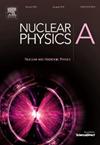Hyperfine mass splittings in ground and radially excited states of heavy-flavored QQQ¯Q¯ tetraquarks: PGM defect and fractional order effects
IF 2.5
4区 物理与天体物理
Q2 PHYSICS, NUCLEAR
引用次数: 0
Abstract
In this study, we investigate the masses and fall-apart decays of the radial excitations in and tetraquarks using a framework that incorporates topological defects and fractional-order derivatives via the generalized conformable fractional formalism. The interaction potential combines the Cornell potential with harmonic oscillator and inversely quadratic terms, adapted for diquark configurations. The Hamiltonian includes spin-independent and spin-dependent components, with the latter breaking degeneracies between spin singlets and triplets. The Schrödinger equation is solved analytically using the generalized fractional Nikiforov-Uvarov method. Our analysis focuses on axial-vector diquarks in the ground () and first radially excited states (), ensuring compliance with symmetry principles. The computed diquark and tetraquark masses, for states with , and , align well with existing results, with deviations within reasonable ranges. Incremental differences observed in our models with varying δ values highlight the influence and adaptability of the fractional parameter, providing insights into the modeling approach. Heavy tetraquark states should be broad and difficult to detect experimentally. However, for some first radially excited states, we have calculated masses below their corresponding two-meson thresholds, indicating stability against fall-apart decays, while others with masses above these thresholds are likely to decay rapidly. The enhanced stability of lower-mass states increases their chances of experimental observation, as ongoing accelerator experiments search for exotic hadrons. Additionally, it is found that the and structures observed by ATLAS in the di- invariant mass spectrum can be attributed to the and states, respectively. These findings, consistent with prior studies, deepen our understanding of exotic hadrons and emphasize the significance of fractional dynamics and topological defects in quark-quark interactions, offering a solid foundation for future research on heavy tetraquark systems.
重味QQQ¯Q¯四夸克的基态和径向激发态的超精细质量分裂:PGM缺陷和分数阶效应
在这项研究中,我们利用一个包含拓扑缺陷和分数阶导数的框架,通过广义符合分数阶形式,研究了ccc¯c¯和bbb¯b¯四夸克中径向激发的质量和崩解衰变。相互作用势结合了康奈尔势、谐振子和逆二次项,适用于双夸克构型。哈密顿量包括自旋独立分量和自旋依赖分量,后者在自旋单重态和三重态之间破缺简并。利用广义分数Nikiforov-Uvarov方法解析求解Schrödinger方程。我们的分析重点是在地面(13S1)和第一径向激发态(23S1)的轴矢量重夸克,确保符合对称原则。对于JPC=0++, 1+ -和2++的状态,计算得到的双夸克和四夸克质量与现有结果一致,偏差在合理范围内。我们在不同δ值的模型中观察到的增量差异突出了分数参数的影响和适应性,为建模方法提供了见解。重四夸克态应该是广泛的,并且难以通过实验检测到。然而,对于一些最初的放射状激发态,我们已经计算出质量低于它们相应的双介子阈值,表明稳定的衰变,而其他质量高于这些阈值的可能会迅速衰变。随着正在进行的加速器实验寻找外来强子,低质量态稳定性的增强增加了它们被实验观察到的机会。此外,我们还发现,在双j /ψ不变质谱中,由ATLAS观测到的X(6400)和X(6600)结构可以分别归属于T(4c)0++(6469)(2S)和T(4c)2++(6643)(2S)态。这些发现与以往的研究结果一致,加深了我们对外来强子的理解,强调了分数动力学和夸克-夸克相互作用中拓扑缺陷的重要性,为未来重四夸克系统的研究提供了坚实的基础。
本文章由计算机程序翻译,如有差异,请以英文原文为准。
求助全文
约1分钟内获得全文
求助全文
来源期刊

Nuclear Physics A
物理-物理:核物理
CiteScore
3.60
自引率
7.10%
发文量
113
审稿时长
61 days
期刊介绍:
Nuclear Physics A focuses on the domain of nuclear and hadronic physics and includes the following subsections: Nuclear Structure and Dynamics; Intermediate and High Energy Heavy Ion Physics; Hadronic Physics; Electromagnetic and Weak Interactions; Nuclear Astrophysics. The emphasis is on original research papers. A number of carefully selected and reviewed conference proceedings are published as an integral part of the journal.
 求助内容:
求助内容: 应助结果提醒方式:
应助结果提醒方式:


